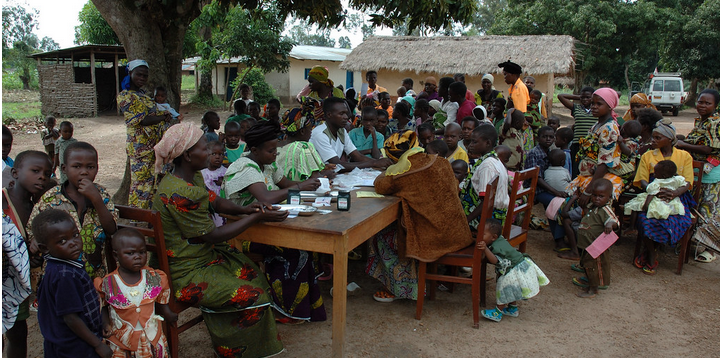Effective Interventions for Improving Routine Childhood Immunisation in Low and Middle-Income Countries: A Systematic Review of Systematic Reviews

International Initiative for Impact Evaluation (Jain, Shisler, Parsekar, Leon); University of East Anglia (Duvendack)
"To support policymakers and practitioners in making evidence-informed decisions on the interventions that have been effective in addressing the barriers to routine vaccination uptake, it is imperative to provide systematically synthesised evidence."
Many low- and middle-income countries (LMICs) struggle to achieve high immunisation coverage due to challenges on both the supply side (health system oriented) and demand side (caregiver oriented). This umbrella review - a systematic review of systematic reviews - provides a synthesis of the interventions that are effective in providing routine immunisation outcomes for children in LMICs.
The researchers searched 11 academic databases and 23 grey literature sources for systematic reviews assessing the effectiveness of any intervention on routine childhood immunisation outcomes in LMICs. The search was adopted from an evidence gap map on routine child immunisation sector in LMICs that was conducted on May 5 2020; the search was updated in October 2021. A mixed-methods synthesis was employed focusing on meta-analytical and narrative elements to accommodate both the quantitative and qualitative information in the reviews. Of the 62 included reviews, 18 are categorised as high confidence, 6 are of medium confidence, and 38 are of low confidence
Overall, the evidence base is highly heterogenous in terms of scope, intervention types, and outcomes. Table 2 in the paper (and online supplemental appendix 9) summarises the key findings across all high- and medium-confidence reviews across all intervention categories. Most of the evidence is centred on caregiver-oriented interventions that have positive and statistically significant effects. For example:
- Sensitisation and education campaigns mostly address the knowledge gaps of caregivers on the importance of vaccinations, importance of maintaining a schedule, and potential misconceptions around vaccinations. This information is delivered by either frontline health workers or trained facilitators at the health facility, at caregiver homes, or in community groups. For short-term sensitisation and education campaigns, the average risk ratio (RR) was 1.38 (95% confidence interval (CI) 1.33 to 1.44), suggesting that the average outcome differed significantly from zero (z=47.37, p<0.001).
- As for written or pictorial messages (short message service (SMS), stickers, flyers, etc.) to caregivers, the average RR of the baseline model stands at 1.24 (95% CI 1.11 to 1.36, p<0.001). The researchers note that SMS reminders delivered to the mobile phones of caregivers address the practical barriers that they face regarding when and where to take their child for a vaccine or follow-up doses. Thus, these interventions can be effective in improving vaccine uptake in communities where such barriers are prevalent.
For health-system-oriented interventions, the evidence base is thin and derived from narrative synthesis suggesting positive effects for home visits, mixed effects for pay-for-performance schemes, and inconclusive effects for contracting out services to non-governmental providers. For all other interventions under this category, the evidence is either limited or not available.
As for community-oriented interventions, the evidence base is very limited, focused on narrative synthesis and finding inconclusive results. However, one high-quality mixed-methods review on single and multicomponent community engagement interventions uses a nuanced framework to classify them based on the process of engaging communities and finds them to be effective using meta-analytical methods. The researchers found no evidence on interventions related to non-health-related policies and institutions.
This review also assessed the interventions aiming to improve zero-dose outcomes through diphtheria, pertussis, and tetanus (DPT1) and Bacille Calmette-Guérin (BCG) vaccine uptake. The researchers found four reviews suggesting inconclusive evidence for interventions improving DPT1 outcomes. However, for BCG vaccine uptake, they found pay-for-performance schemes (one qualitative review) and community engagement interventions (one quantitative review) to be effective.
Reflecting on the findings, the researchers note that, overall, the evidence base provides clearer answers on the effectiveness of caregiver-oriented interventions and to a certain degree of community-oriented interventions than of health system-oriented interventions. In fact: "Interventions oriented towards caregivers and communities are effective in improving routine child immunisation outcomes."
Some possible future research directions include:
- Researchers, programme implementers, and policymakers have explored using monetary incentives to motivate caregivers to vaccinate their children; there have been a substantial number of experiments involving conditional and/or unconditional cash transfer schemes to assess their effectiveness in improving immunisation outcomes. However, the evidence does not provide a clear answer on their effectiveness, and there is a need for an updated review with a more inclusive search strategy for identifying relevant articles published in non-health journals.
- Two intervention categories that are of specific policy relevance and would benefit from a stronger evidence base are: (i) interventions focusing on building skills, capacity, and motivation of formal health workers and (ii) new health management information system (HMIS)/dashboard systems - that is, interventions leveraging digital technologies, which are increasingly being adopted and expanded across LMICs.
- It is unclear which intervention combinations work best in terms of improving immunisation outcomes. Further theory development may be a starting point for contributing to a better understanding of the enablers and barriers of interventions, as well as unpacking underlying causal mechanisms and thus improving the selection and targeting of immunisation programmes.
- Further work is needed in improving the quality of both systematic reviews and primary studies.
BMJ Open 2024;14:e074370. doi:10.1136/bmjopen-2023-074370. Image credit: Julien Harneis via Flickr (CC BY-SA 2.0 Deed)
- Log in to post comments
